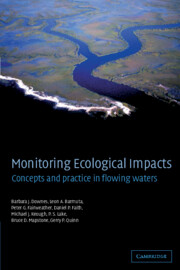Book contents
- Frontmatter
- Contents
- Preface and Acknowledgements
- Part I Introduction to the nature of monitoring problems and to rivers
- 1 Why we need well-designed monitoring programs
- 2 The ecological nature of flowing waters
- 3 Assessment of perturbation
- Part II Principles of inference and design
- Part III Applying principles of inference and design
- References
- Index
1 - Why we need well-designed monitoring programs
Published online by Cambridge University Press: 21 August 2009
- Frontmatter
- Contents
- Preface and Acknowledgements
- Part I Introduction to the nature of monitoring problems and to rivers
- 1 Why we need well-designed monitoring programs
- 2 The ecological nature of flowing waters
- 3 Assessment of perturbation
- Part II Principles of inference and design
- Part III Applying principles of inference and design
- References
- Index
Summary
HUMAN PRESSURES ON FLOWING WATERS
How serious are the current and future problems created by human activities on flowing waters? Impacts on ecological processes from altered flows, salinization, organic pollution, exotic species and the like can be very difficult to assess. These pressures being placed on global water sources can be seen convincingly in some statistics on the proportions of stream and river flow used by human beings.
First, fresh water comprises about only 2.5% of the Earth's total volume of water. After subtracting the volumes of fresh water locked up in ice caps and glaciers, only 0.77% (∼ 10 665 000km3) is left as free fresh water (i.e. in aquifers, soil pores, wetlands, streams etc.; Postel et al. 1996). Flowing waters are only a very small fraction of the world's fresh water, with global annual runoff being about 40 700km3 (Postel et al. 1996) or ∼ 0.003% of the Earth's total volume of water. However, like atmospheric water, the surface movement of fresh water into and out of rivers and streams is high and the residence time is low (c. 8–14 days).
Human beings use or affect a high proportion of this water. Human-made impoundments now have a major influence on the flow and ecology of many rivers, storing about 14% (5500km3) of total annual runoff. Human use of fresh waters is rapidly rising as populations increase and standards of living rise (e.g. daily consumption of rural peasants may be 50 L per person compared with 400 L per head for an affluent householder; Newson 1994).
- Type
- Chapter
- Information
- Monitoring Ecological ImpactsConcepts and Practice in Flowing Waters, pp. 3 - 13Publisher: Cambridge University PressPrint publication year: 2002



